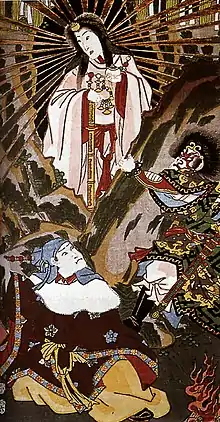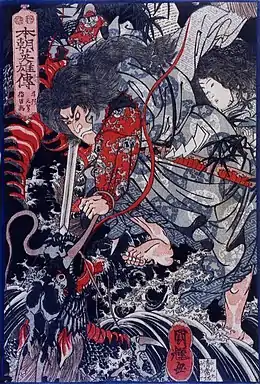Konohanasakuya-hime
Konohanasakuya-hime is the goddess of Mount Fuji and all volcanoes in Japanese mythology; she is also the blossom-princess and symbol of delicate earthly life.[1][2] She is often considered an avatar of Japanese life, especially since her symbol is the sakura (cherry blossom).
| Konohanasakuya-hime | |
|---|---|
Nature deity | |
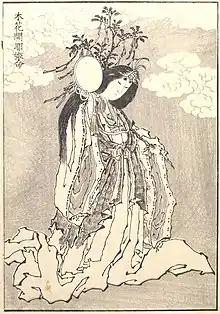 Konohanasakuya-hime | |
| Other names | Konohananosakuya-hime Sakuya-hime Sengen Asama no Okami |
| Japanese | 木花咲耶姫 木花開耶姫 |
| Affiliation | Blossoms, life, Mount Fuji, volcanoes |
| Major cult center | Asama shrines |
| Abodes | Mount Fuji |
| Symbol | Sakura cherry blossom |
| Texts | Kojiki, Nihon Shoki |
| Gender | Female |
| Region | Japan |
| Personal information | |
| Parents | Ōyamatsumi |
| Siblings | Iwanaga-hime |
| Consort | Ninigi |
| Offspring | Hoderi, Hosuseri, Hoori |
Shinto shrines have been built on Mount Fuji for Sakuya-hime, collectively known as the Asama or Sengen Shrines. It is believed that she will keep Mount Fuji from erupting,[3] but shrines to her at Kirishima have been repeatedly destroyed by volcanic eruptions. She is also known for having torn up the Yatsugatake Mountains, because it was higher than Fujiyama.
Name and etymology
Konohanasakuya-hime or Konohananosakuya-hime (木花咲耶姫 or 木花開耶姫; lit. "[cherry] tree blossom blooming princess" (princess, or lady of high birth explains hime; her name also appears in a shorter form as "Sakuya-hime",[4] and she is also called Sengen[5]))
Myths
Ninigi and Sakuya-hime
Sakuya-hime met Ninigi on the seashore and they fell in love; Ninigi asked Ohoyamatsumi, the father of Sakuya-hime for her hand in marriage. Oho-Yama proposed his older daughter, Iwa-Naga-hime, instead, but Ninigi had his heart set on Sakuya-hime. Oho-Yama reluctantly agreed and Ninigi and Ko-no-hana married. Because Ninigi refused Iwa-Naga, the rock-princess, human lives are said to be short and fleeting, like the sakura blossoms, instead of enduring and long lasting, like stones.
Sakuya-hime became pregnant in just one night, causing suspicion in Ninigi. He wondered if this was the child of another kami. Sakuya-hime was enraged at Ninigi's accusation and entered a doorless hut, which she then set fire to, declaring that the child would not be hurt if it were truly the offspring of Ninigi. Inside the hut, Ko-no-hana had three sons, Hoderi, Hosuseri and Hoori.[6][7]
Yosoji's camellia tree
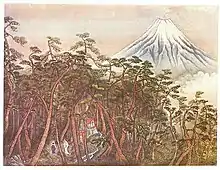
According to an 11th-century legend, a small village in the Suruga Province named Kamiide was struck by smallpox epidemic. In the village, there lived a young boy named Yosoji and his mother, who was infected by the disease. To cure his mother, Yosoji went to a fortune teller who told him to give his mother water from a small stream near Mount Fuji.
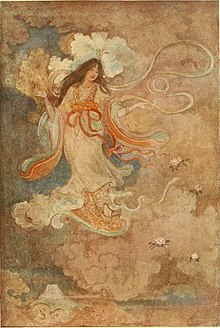
The next day, Yosoji decided to go to the river, but then stumbled upon three different paths, not knowing which one to take. A young girl in white came towards Yosoji from the forest and guided him to the stream. Yosoji scooped up water from the stream and gave it to his mother to drink.
Days later, Yosoji went back to the area where the three paths met, and met the girl in white once again. She told him to come back in three days, and that she would meet him there. She also told him that it would take five trips to the stream to treat all the villagers.
Five trips later, Yosoji's mother was healed, and so were many other villagers. The villagers thanked him, but he knew that he owed it all to the girl in white. So he went back to the stream to give thanks to the girl in white. However, he found that the stream was completely dried up and the girl was nowhere to be seen. Thus, Yosoji prayed that the girl would reveal herself, so that he might thank her for her actions.
The girl appeared before him and Yosoji said that he wished to tell her how deeply grateful he was to her and that he wished to know who she was, so he could tell the villagers whom to thank. The girl in white said that her identity was not important and said farewell to Yosoji. She then swung a branch of camellia over her head and a cloud from Mount Fuji came down and picked her up. Yosoji realized the woman was none other than the Goddess of Mount Fuji.[8]
Genealogy
| Amaterasu | Takamimusubi | ||||||||||||||||||||||||||||||||||||||||||||||||||||||||||
| Ame-no-oshihomimi | Takuhadachiji-hime | Ōyamatsumi | |||||||||||||||||||||||||||||||||||||||||||||||||||||||||
| Ninigi-no-Mikoto (天孫) | Konohanasakuya-hime | Watatsumi | |||||||||||||||||||||||||||||||||||||||||||||||||||||||||
| Hoderi | Hosuseri (海幸彦) | Hoori (山幸彦) | Toyotama-hime | Utsushihikanasaku | Furutama-no-mikoto | ||||||||||||||||||||||||||||||||||||||||||||||||||||||
| Tensori no Mikoto | Ugayafukiaezu | Tamayori-hime | Azumi people | (Owari clan Yamato clan) | |||||||||||||||||||||||||||||||||||||||||||||||||||||||
| Hayato people | Itsuse | Inahi | Mikeiri | Jimmu | Ahiratsu-hime | ||||||||||||||||||||||||||||||||||||||||||||||||||||||
| Imperial House of Japan | Tagishimimi | ||||||||||||||||||||||||||||||||||||||||||||||||||||||||||
- Red background is female.
- Green background means groups
- Bold letters are three generations of Hyuga.
References
- Nihongi: Chronicles of Japan from the Earliest Times to A.D. 697, translated from the original Chinese and Japanese by William George Aston. Book I, page 71. Tuttle Publishing. Tra edition (July 2005). First edition published 1972. ISBN 978-0-8048-3674-6
- Coulter, Charles Russell; Turner, Patricia (2013-07-04). Encyclopedia of Ancient Deities. Routledge. ISBN 978-1-135-96390-3.
- "In A.D. 806 a local official built a shrine near the foot of the volcano to keep it from erupting. The priests assigned the task of pacifying the mountain apparently neglected their duties because Fuji erupted with great violence in 864, causing much damage in a nearby province. The governor of that province blamed the priests for failing to perform the proper rites and constructed another shrine in his own territory, where he could make sure everything was done correctly. A fiery god of the mountain became at a later date the more peaceful Shinto goddess of Mount Fuji-- Konohana Sakuya Hime-- the Goddess of Flowering Trees." "Konohana Sakuya Hime originally had little or no connection with Mount Fuji. Sometime between the 14th and 16th centuries, the belief arose among the people of the region that she would protect them from eruptions of the volcano as she had her newborn son from the flames of the burning bower." Konohana is now the principal goddess of Mount Fuji. Members of Fuji-ko have altars in their own home in which they worship Konohana Sakuya Hime. This group also lights a torch for Konohana Sakuya Hime at the fire ceremony at Fuji-Yoshida.
- "Creation stories". gly.uga.edu/. Archived from the original on 27 January 2016. Retrieved 20 January 2016.
- Cartwright, M ark (12 April 2017). "Mount Fuji". Ancient History. Retrieved 16 August 2019.
- Nihongi: Chronicles of Japan from the Earliest Times to A.D. 697, translated from the original Chinese and Japanese by William George Aston. Book II, page 73. Tuttle Publishing. Tra edition (July 2005). First edition published 1972. ISBN 978-0-8048-3674-6
- "According to the 'Kojiki', the great 8th century A.D. compilation of Japanese mythology, Konohana Sakuya-hime married a god who grew suspicious of her when she became pregnant shortly after their wedding. To prove her fidelity to her husband, she entered a benign bower and miraculously gave birth to a son, unscathed by the surrounding flames. The fire ceremony at Fuji-Yyoshida recalls this story as a means of protecting the town from fire and promoting easy childbirth among women."
- Richard Gordon Smith (1908). "Yosoji's Camellia Tree". Ancient Tales and Folklore of Japan. Illustrated by Ella Du Cane – via Google Books.
- Persona 4 Visual Data. Atlus. 2008. p. 60.
External links
- "FUJISANHONGU SENGENTAISHA". Retrieved 2021-03-01. - Official homepage of the Asama shrines near Mount Fuji
